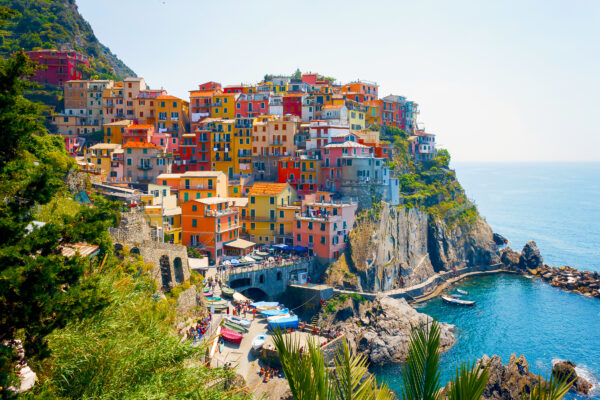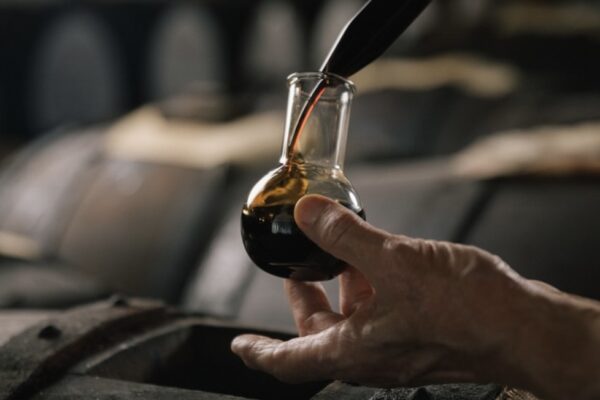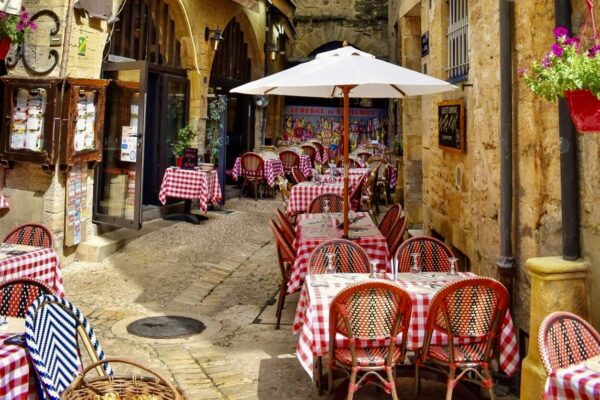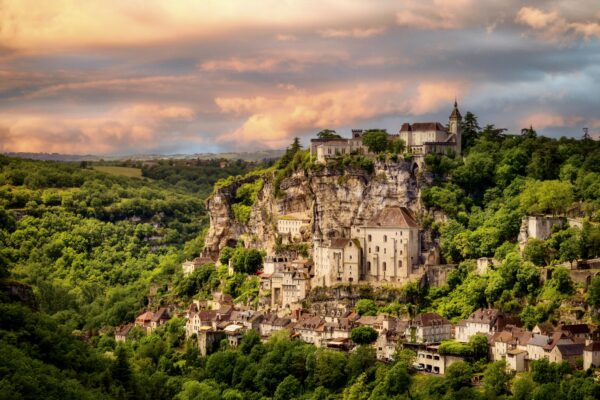Piedmont: Hilltop Paradise
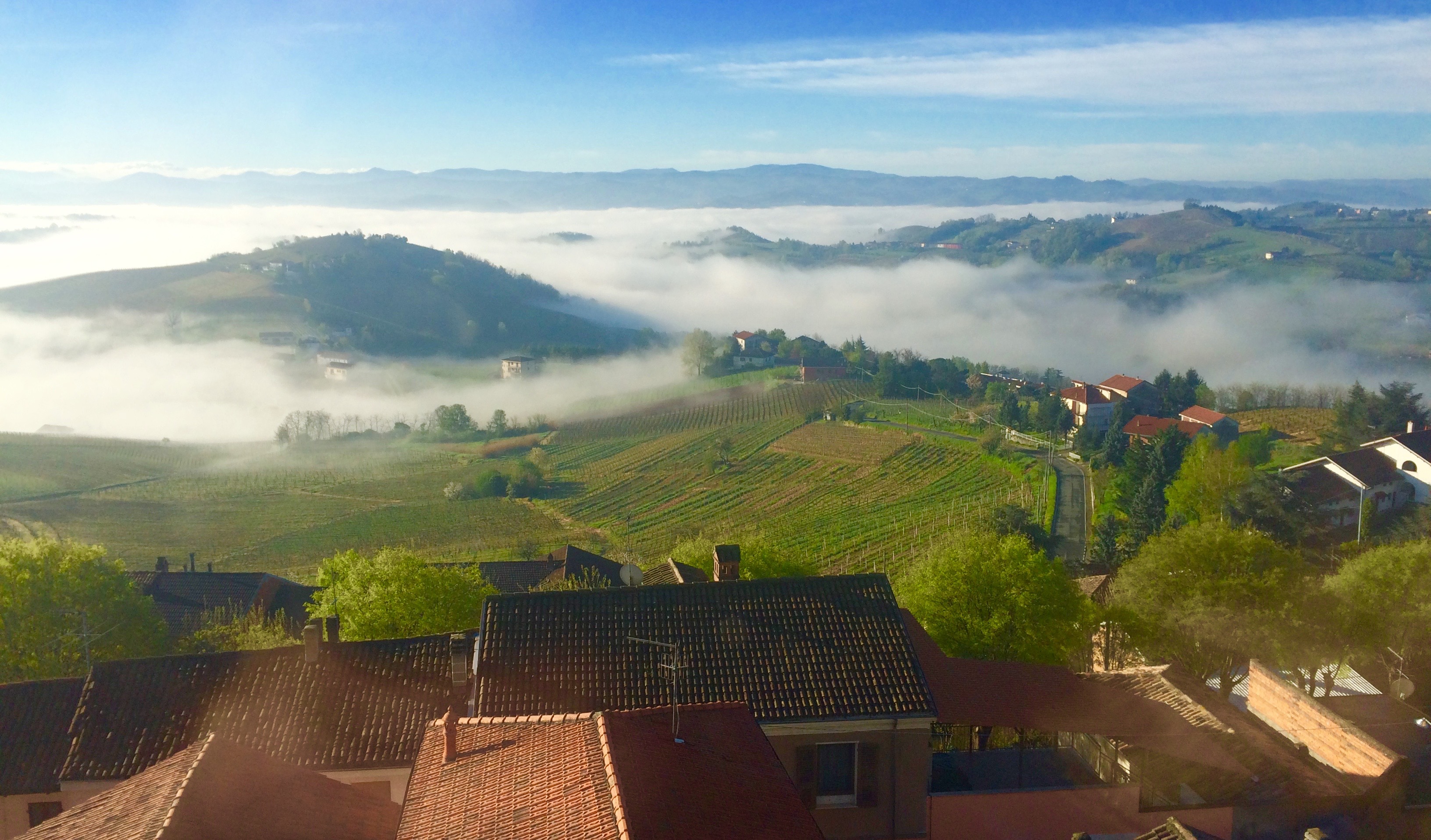
Views from the Hotel Belvedere in Alice Bel Colle. Photo by Marla Norman.
by Marla Norman, Publisher
It’s my first day in Alice Bel Colle and I feel as if I’ve taken a dive over the hotel balcony. Thick heavy clouds cover the landscape and are so close I can literally reach out and touch them. The green hills of nearby villages are submerged, like islands in a cosmic stream. Colors undulate and swirl, as the huge, billowy giants morph into small, then smaller creatures…ultimately vanishing entirely…
Miles of vineyards – running up impossibly sheer slopes – are visible now. Italy’s famed Barolo, Nebbiolo, Barbera, Dolcetto and Asti Spumante are all produced in the region. Sweet little towns sit perched at the top of every other hill – like so many jewels crowning the Piedmont Kingdom.
My drive through the the Alps the previous day was also filled with Ooh-Ah moments! Not only is the scenery spectacular, but hairpin turns on narrow roads dangling over mile-high precipices add to the breathtaking effect. Imagine a combination of Colorado’s Independence Pass and Maui’s Hana Highway.
A small roadside inn at Giovo Ligure, Albergo Ligure provided a well-timed break. The restaurant is modest, but the owners are warm and welcoming. Plates of fettuccine and pesto are fresh – the smell of basil floats out from the kitchen. A side dish of fennel with caramelized onions is delicate yet savory, with a flavor so distinctive I don’t even recognize it as fennel initially. The owners lug out Italian/English dictionaries to help identify the mysterious vegetable – finocchio.
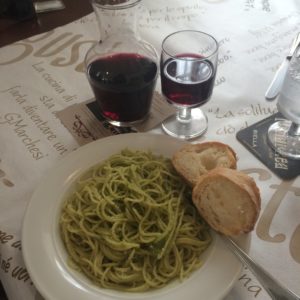
Melt-in-your-mouth fresh pasta & pesto with regional Dolcetto. Photos by Marla Norman.
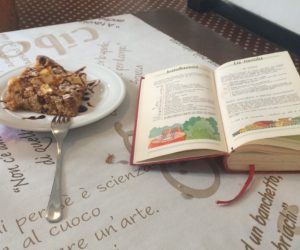
Apple cake with caramel sauce and a well-seasoned Italian cookbook.
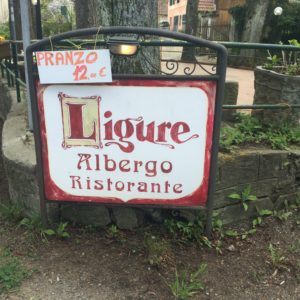
Melt-in-your-mouth food, loving service and friendly prices at Ligure Albergo Ristorante.
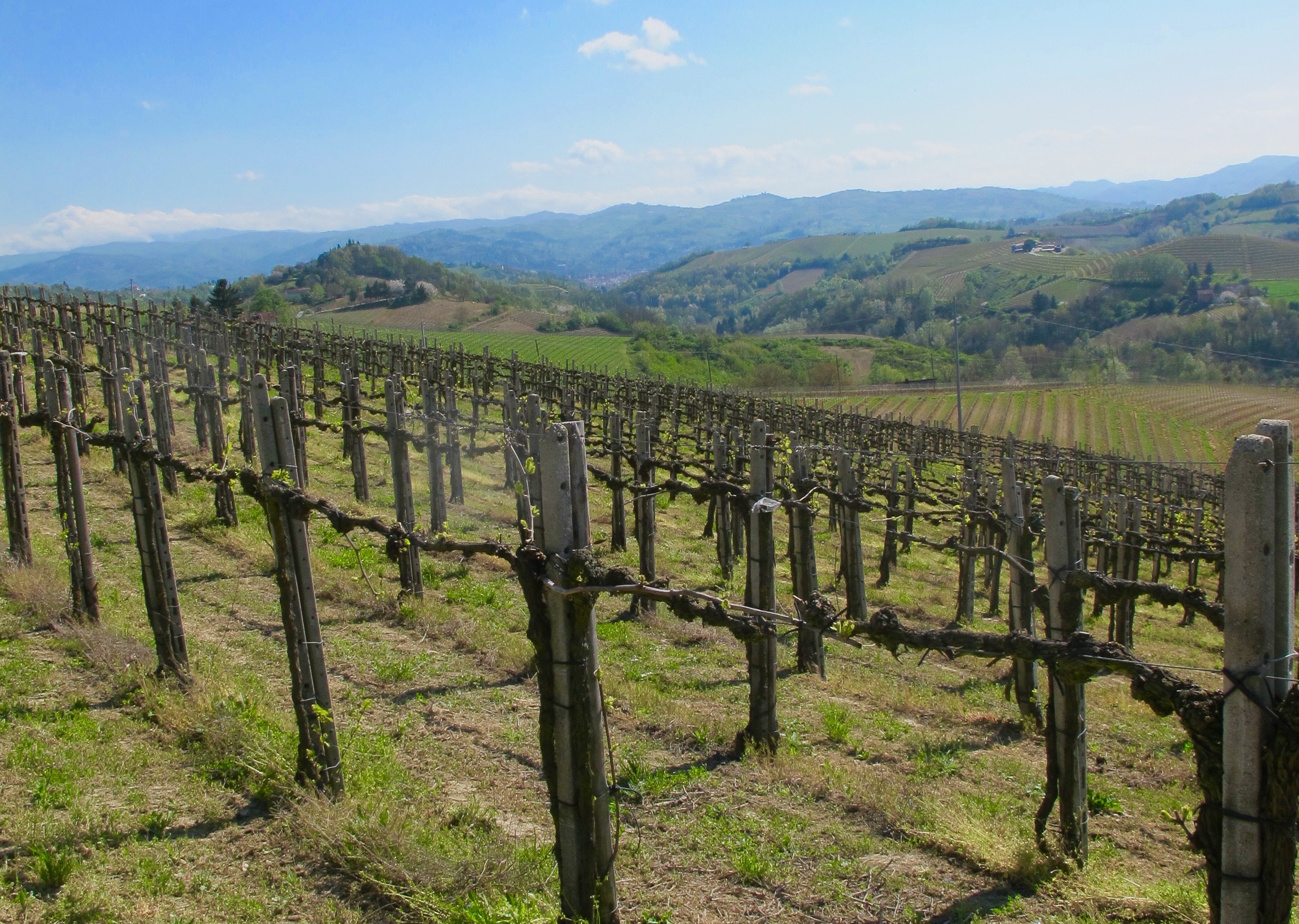
The road to Alice Bel Colle. Photo by Marla Norman.
VINO VINO VINO!
“Buongiorno! Benvenuto!” Daniele Bianco, Export Director at Cantina Alice Bel Colle, greets us enthusiastically. Michel Thibault (Michel Thibault Wine LLC) and I are lucky enough to be tasting the wines produced by this group, a wine-cooperative that consists of 110 members with a total of 370 Hectares or 914 acres. Most of the partners are 4th or 5th generation grape producers.
“Believe me, they know their vineyards row by row,” Daniele smiles, as he pours glasses of Casarei. Made from Cortese, one of the most typical white grape varieties in Piedmont, Casarei has citrus flavors and minerality – a nice flavor profile to begin the tasting.
Slowly and methodically, we work our way through the wines. Swirling, smelling, sipping and spitting – along with copious note taking. We taste a beautiful Fraschetta – Piedmont’s Chardonnay – with stone fruit and melon.Then on to a deep purple Dolcetto – Coste di Muiran – with black cherries, raspberries and plums.
Up next is my personal favorite – the Barbera d’Asti. Grapes used for this wine come from the oldest vineyard in the area.The color of the wine is an intense ruby red. The flavor is black cherries with a bit of prune and almonds to finish. Delizioso!
“What do you think?” asks Daniele after uncorking the tenth selection. “Should we continue? Or stop for lunch. I know a place that makes great gnocchi. Later, we can return to taste the sparkling wines.”
We quickly agree that lunch is in order after such “demanding” work.
See more on the wines of Alice Bel Colle and Piedmont – Nebbiolo: Piedmont’s Wine King and Piedmont’s Other Jewels

Daniele Bianco, Export Director at Cantina Alice Bel Colle, presents the company’s sparkling wines. Photo by Marla Norman.
ALBA’S ENOLOGY CAMPUS
We are TEARING UP the Piedmontese backroads. Daniele is driving his little Fiat like a Formula 1 racer. The car engine purrs and occasionally growls as he manages the tight turns. Having grown up here, he knows them all by heart. Or at least that’s what I reassure myself as we cruise along.
We slow down in the middle of Alba in front of a large, red-brick building. “This is where I graduated,” Daniele explains. “Scuola Enologica di Alba (Enology School of Alba) is one of three in the country. I began studying wine at the high school here, then continued at the university right over there,” he says, pointing across rows of grapes to another group of buildings. “It’s a six-year program in all, with an average of 40 graduates each year.”
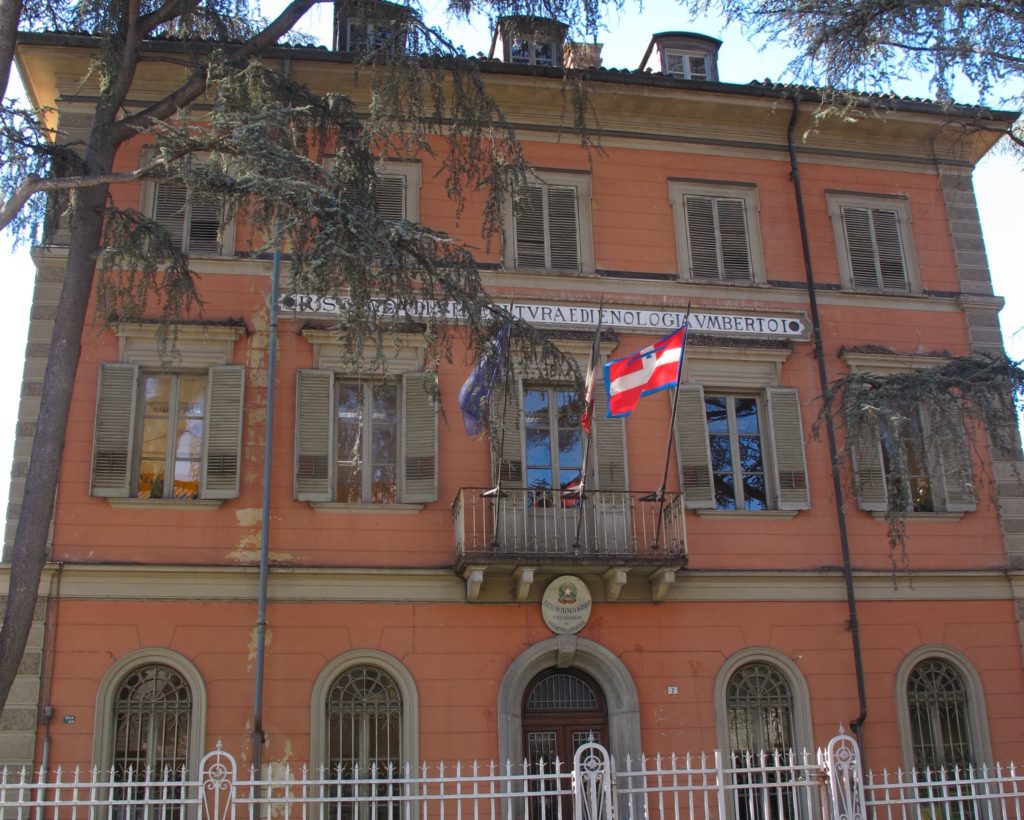
The Scuola Enologica di Alba Enology School of Alba) – shown here is the High School campus. Photo by Marla Norman
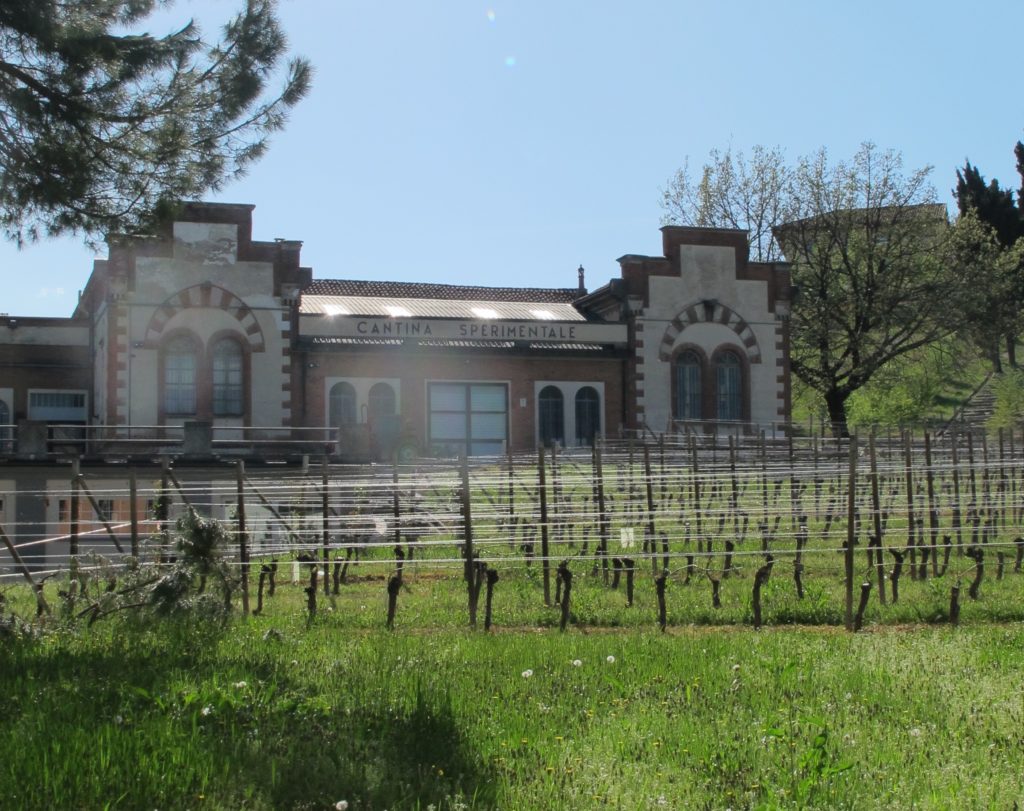
Cantina Sperimentale (Wine Laboratory) at the Scuola Enologica di Alba. Photo by Marla Norman.
The university maintains eight hectares of vineyards as well as a winery which produces about 30,000 bottles annually. A number of grape varietals are cultivated, including many vines from the Americas.The New World stock is grafted with European vines to develop better and hardier stock.
A Side Note: If you’re lucky enough to be in Alba sometime during the second Saturday in October to the second Sunday in November, you can take part in their Fiera Internazionale del Tartufo Bianco (International White Truffle Fair). Merchants, chefs, and truffle lovers pack into the city to celebrate white truffles at the height of the season. Just be forewarned, a pound of the exquisite tubers can run up to €2,200 or $2,486. Indulging in a few wafer thin pieces to garnish your food will run about €20.00.
BAROLO & LA MORRA
From Alba we continue our drive through the gorgeous Piedmont vineyards – each turn and stretch of valley looks like a postcard. We stop in Barolo for a stroll. With under a thousand residents, the village is tiny but incredibly charming. Just the chance to sit at a corner cafe and soak in the views is reason enough to visit.
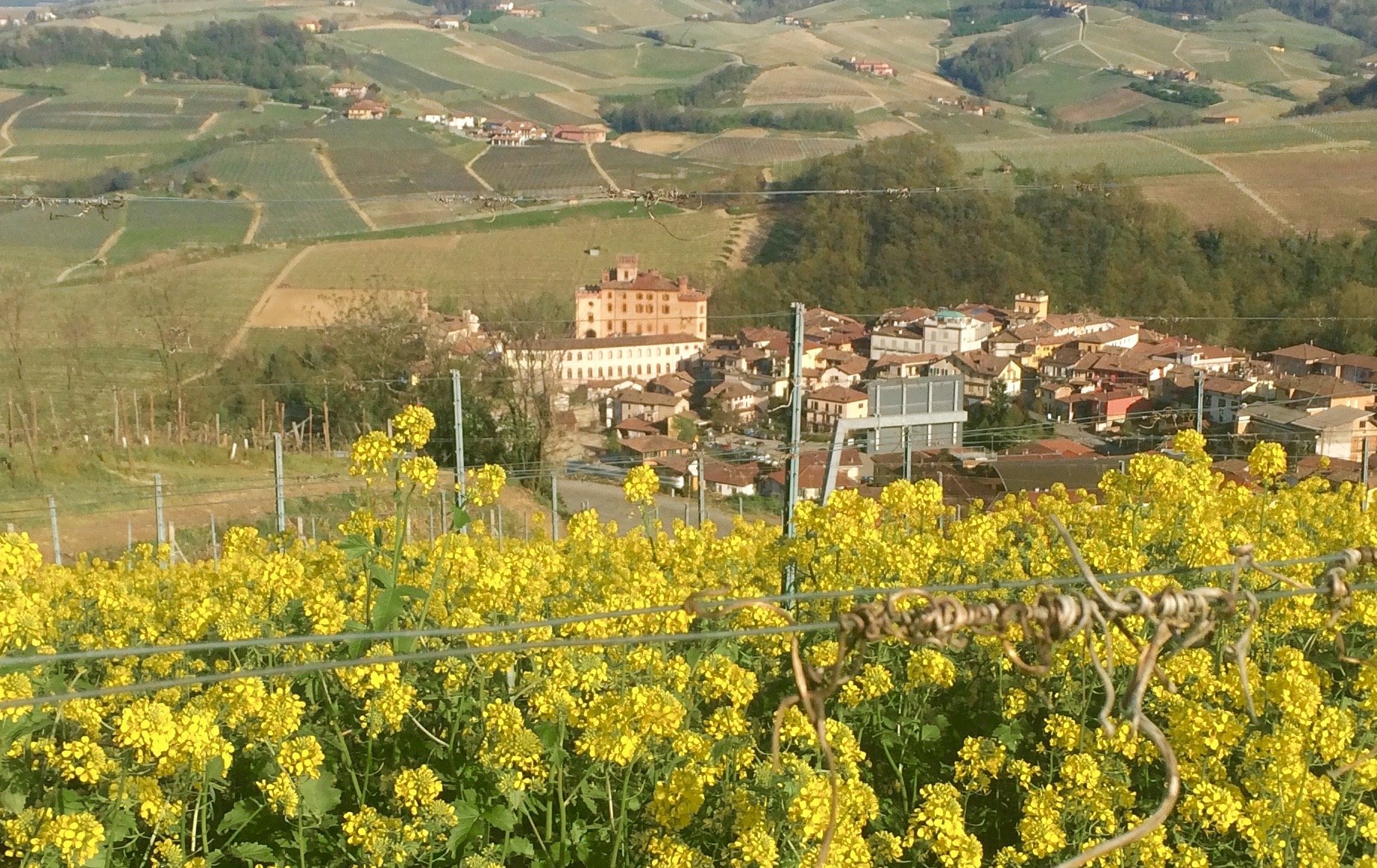
The village of Barolo, surrounded by vineyards. Castello Falletti in view as well. Photo by Marla Norman
For even better views, visit the Castello Falletti, in the center of the village. Historians believe that the castle-fortress dates back to the 10th century and was turned over to the Falletti family during the 13th century. The main salon is furnished in Empire style and is decorated with murals of the four seasons. A library contains some 3,000 volumes from the 15th through the 19th centuries.
A second salon features the coat-of-arms of the Falletti on the ceiling and continues to serve as the meeting room for the local town council. But most visitors agree that the top terrace – with its magnificent panorama over the Bassa Langa and some of the most prestigious Barolo vineyards – is the crowning glory of the castle.
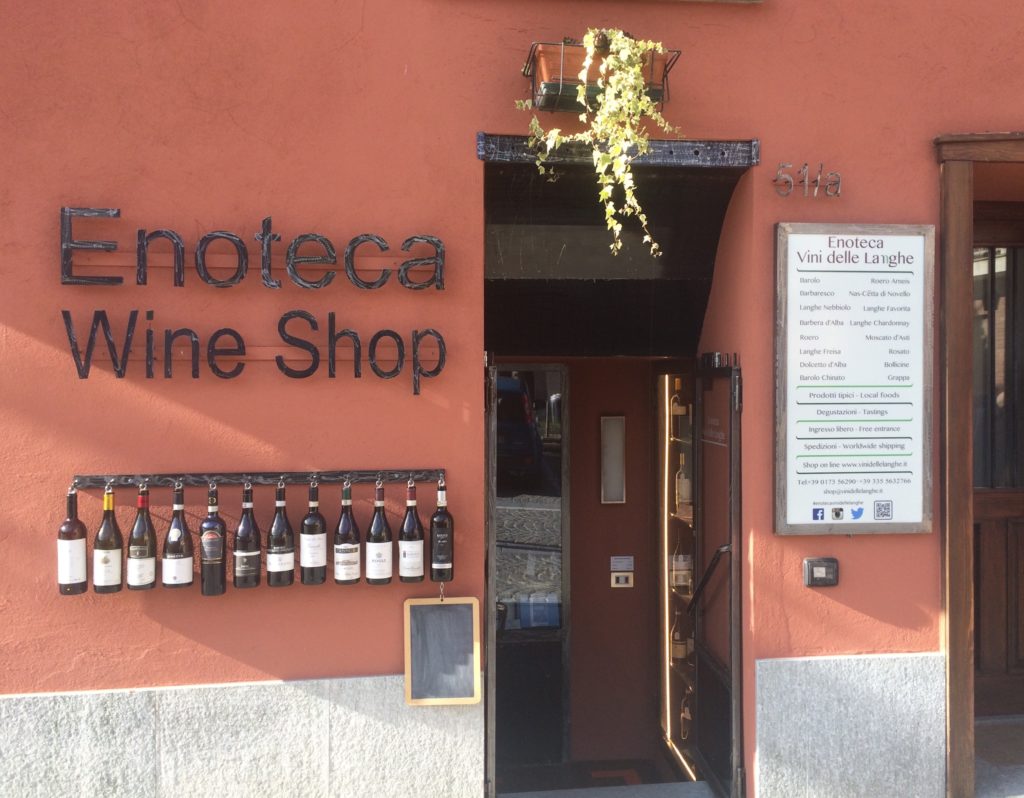
Cute wine shops in Barolo. Photos by Marla Norman.
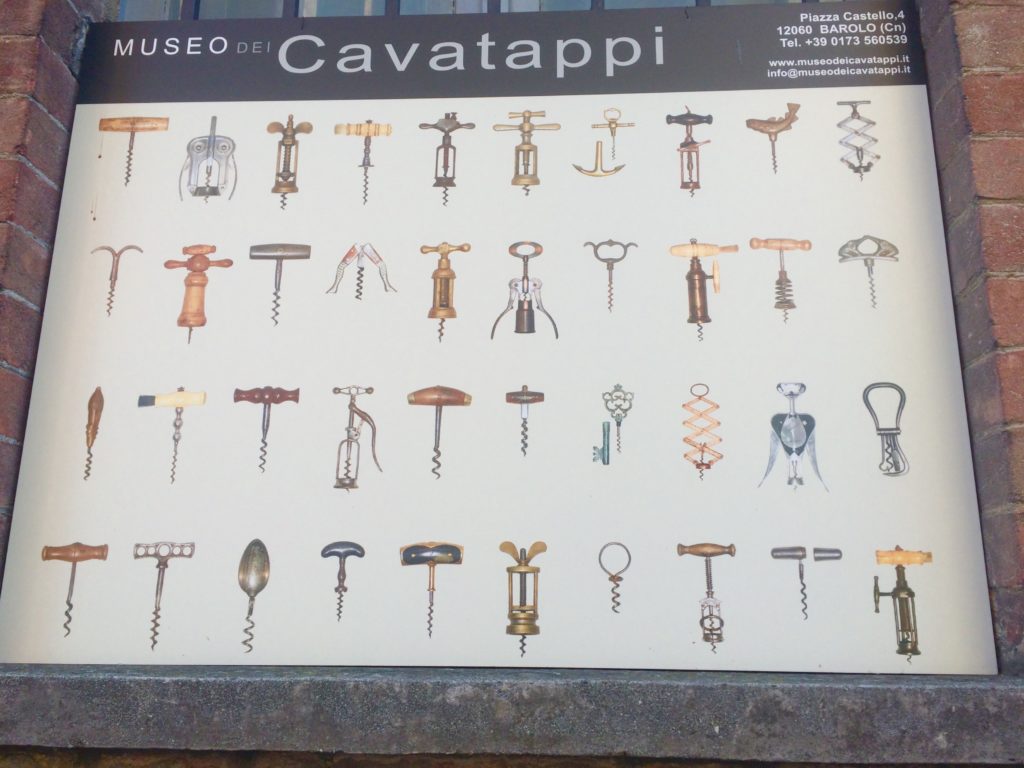
Museo dei Cavatappi in Barolo catalogs over 500 types of corkscrews.
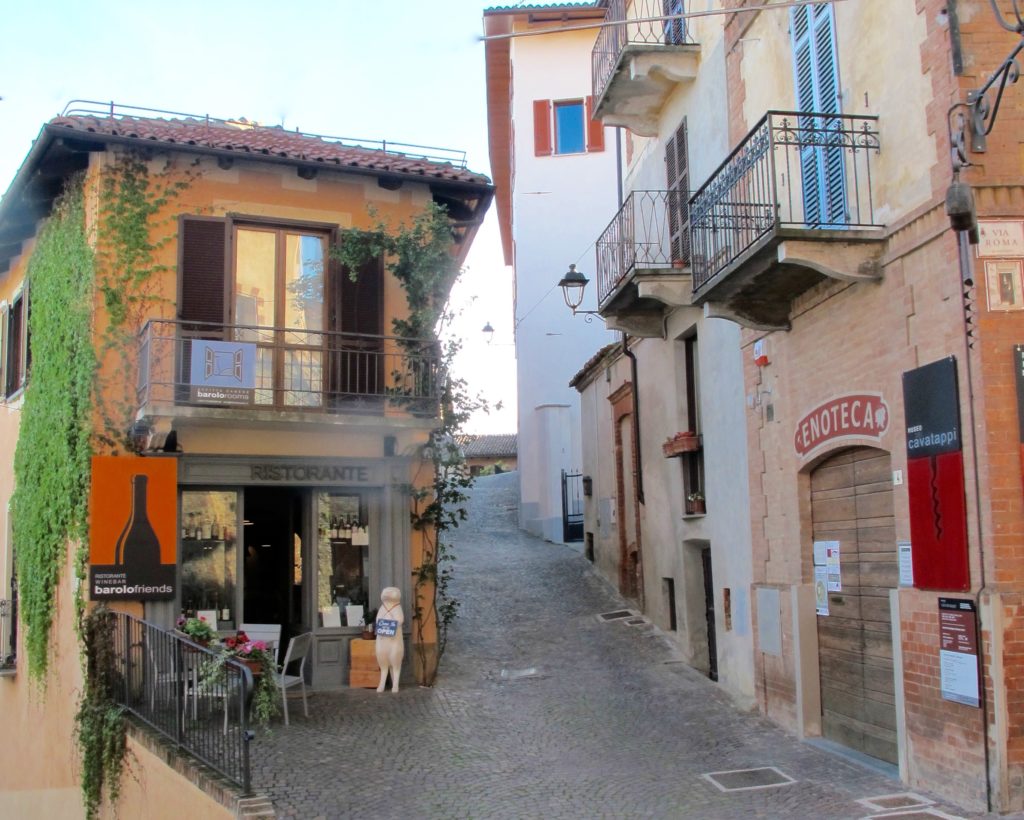
Inviting corner cafe tucked along the cobblestone streets of Barolo.
Museu dei Cavatappi or Corkscrew Museum is also an interesting and worthwhile visit. There are over 500 different types of corkscrews on display – from the 18th century to today – of various artistic periods, countries, and styles. Also in the collection are 100 antique wine cups from around the world. The museum wine shop offers over 300 different wines with a daily tasting.

La Morra, the highest village in the Piedmont region. Photo by Marla Norman
Back in the car, we zoom up the tallest hill in the region to La Morra, home of the Nebbiolo vineyards. A few of the more notable properties include: Marcarini, Renato Ratti, Roberto Voerzio & Gianni Voerzio.
The towering views of La Morra are spectacular, stretching for miles across dozens of Piedmont hilltops and villages. We stroll along the plaza and shops noting that several luxury hotels have located in the site. Tourism in Piedmont continues to expand as visitors are drawn to the scenery and outstanding wines.
Driving down the hillside we blaze past several cars, including one who honks frenetically as we sail past. “Oh! That’s my brother!” exclaims Daniele.
“I guess speedy driving is genetic,” Michel teases him.
Daniele giggles and retorts: “If we drove slowly, we’d never make it around all these big hills. We’d just drive in circles all day.”
We admit he may have a point. Then Daniele confesses that he’s dreaming of the day he can trade his Fiat in on a Range Rover. “That would be a very nice upgrade,” he says winking, then adds: “Tra il dire e il fare c’è di mezzo il mare. Between what we say and what we do lies an ocean.”
Italians can be such practical romantics…
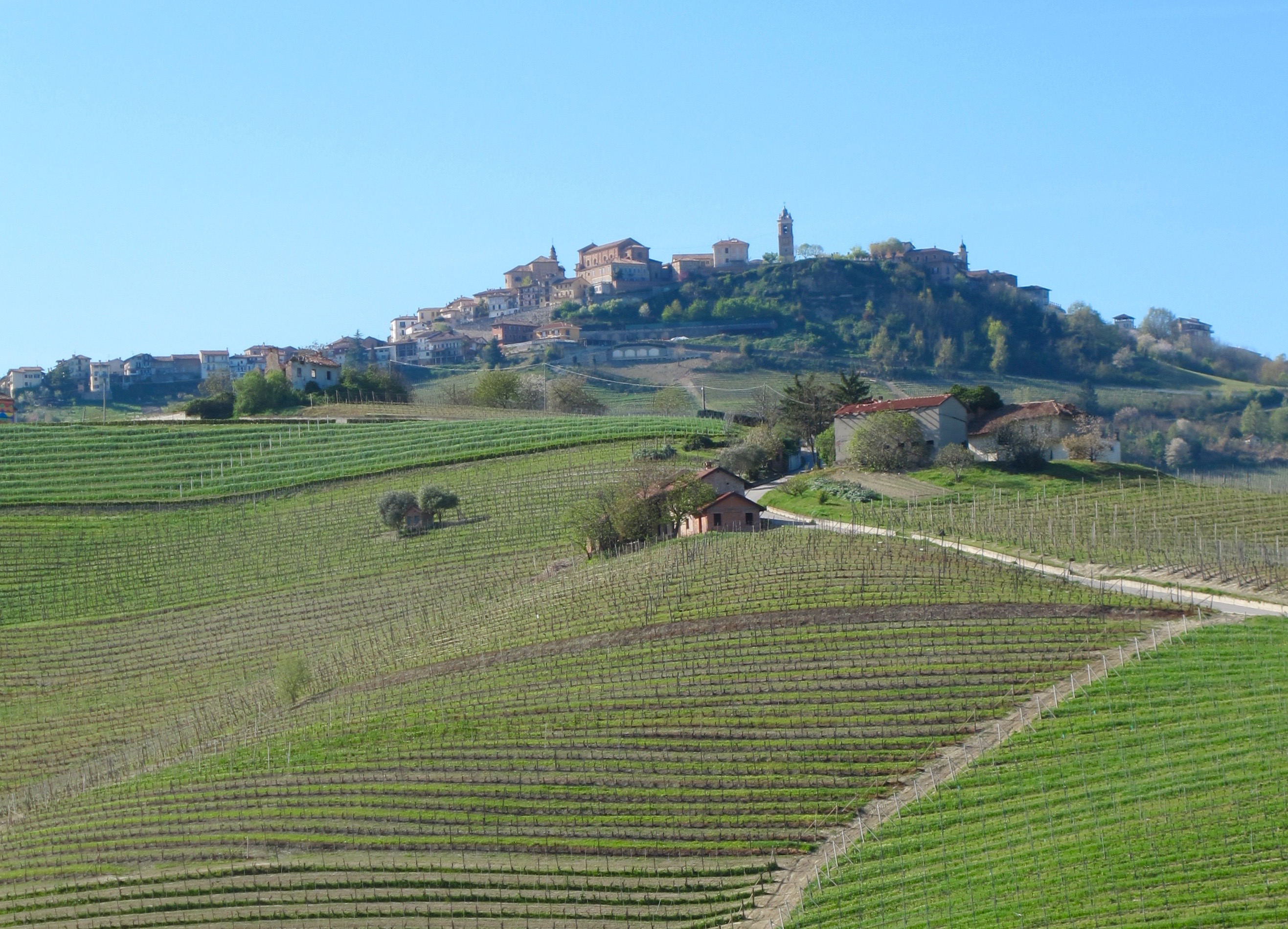
Views of La Morra are spectacular, both from the city and approaching it. Photo by Marla Norman.
ASTI’S PALIO & WINE FESTIVAL
One of the largest cities in Piedmont, Asti, is especially known for its white spumante, but the city sparkles in numerous ways. In the 12th and 13th centuries, Asti was a republic and a major economic force.

A few remaining towers from the original 13th century “City of one-hundred towers.” Photo from Wikipedia
High-rise towers were constructed for defense and to broadcast the city’s importance – a custom well established in Tuscany as well. At the time, Asti was known as “the city of one-hundred towers.” In the city center, a few of those original towers can still be seen.
The city center is also where the Palio d’Asti is held. This annual horse race is a competition between the city’s nine neighborhoods and has existed at least since 1275. The festival is always staged in September, on the feast day of the city’s patron saint, San Secondo. Locals parade in elaborate costumes and enjoy lavish banquets. Bönet – a chocolate and almond pudding cake, soaked in Asti Spumante is a typical dessert served at this time.
The Douja d’Or (National Wine Festival) is held in September as well. For ten days, wine tastings along with musical events are presented. A competition awards all wine producers a score between 85-100. “Samples which score over 90 to 100 enter the top classification of the Douja d’Or. All of the wines selected are entitled to display the “Premio Douja d’Or” label,” according to the Italian Ministry for Agricultural, Food Industry and Forestry Policies.
The Wine Festival, like the Palio, features vintage costumes and a recreation of country life in the 19th century. Food stands offer over 80 different specialities from the region. With so many enticements, it’s no wonder over 300,000 visitors attend the festival annually.
We take a break from our tour of Asti to have lunch with Daniele. He leads us into an alley, through a small door and down an old stairway to a wine cellar – that’s been converted into a restaurant. Tacabanda Restaurant – Enoteca is a wonderfully cozy space with vaulted brick ceilings and racks and racks of wine. Large displays of contemporary art contrast with the weathered walls. Daniele explains that the art exhibitions rotate regularly and are a popular feature of the restaurant.
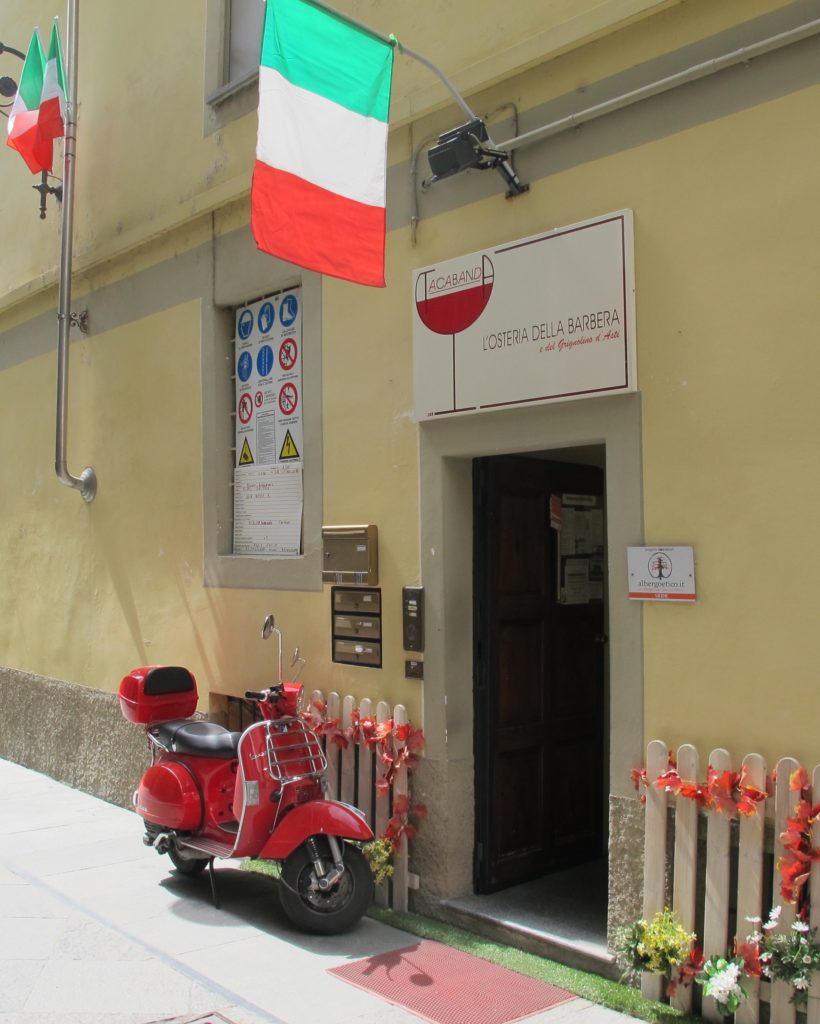
A small door in a back alley leads to Tacabanda Enoteca. Photo by Marla Norman.
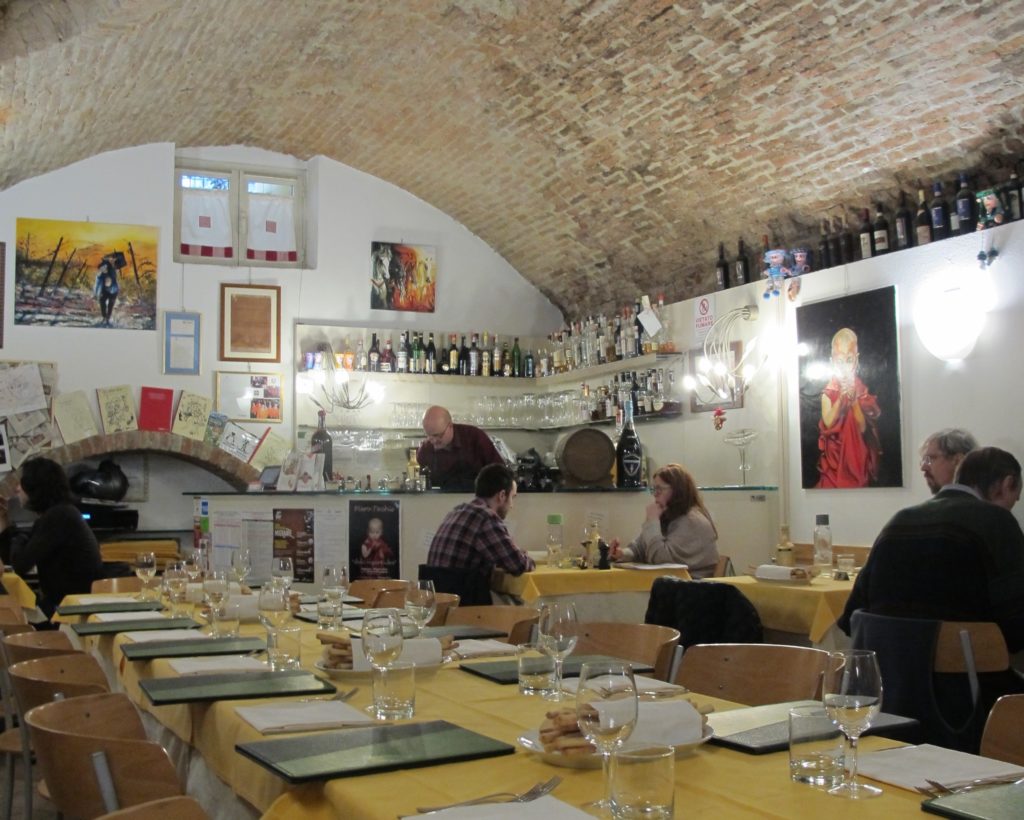
Vaulted brick ceilings and contemporary art at Tacabanda. Photo by Marla Norman.
Not surprisingly, the menu offers a wide choice of wines from the area, along with typical Piedmont and Monferrato dishes. Primi Piatti include baked vegetables, agnolotti, luscious ravioli, Risotto with Radicchio & Castelmagno Cheese and Tagliolini with White Truffles.
Secondi Piatti offerings are Lamb Chops with Hazelnuts wrapped in Filo Pastry, Pork Tenderloin with Bacon & Green Pepper, Sliced Beef with Barbera Sauce and Angler Fish Cheeks with Puccia. And, as if all of that isn’t enough, desserts include the famous Bönet Chocolate Pudding Cake.
But in addition to the fantastic food, art and stylish enoteca, Tacabanda has founded a very special project called “Hotel Ethics.” Their primary goal is to help individuals with learning disabilities and Down Syndrome to function in a work environment. A secondary goal is help the same individuals achieve home cooking autonomy. An incredibly worthwhile mission; moreover, while you’re indulging in rich, delectable food, you’re also helping an exceptional cause.
HOT TIMES AT ACQUI TERME
The hot springs of Acqui Terme have been known for over two millennia. The Romans built baths and fountains to take advantage of the springs in the first and second centuries. Remnants of thermal baths, a theater and amphitheater can be seen. A massive aqueduct still stretches elegantly across the surrounding countryside.
Today La Bollente – a fountain in the middle of the city showcases the steamy waters (75 C/ 167 F), with a tiered cascade running the length of the city’s main street. The Grand Hotel Nuove Terme operates a spa with the thermal waters nearby.
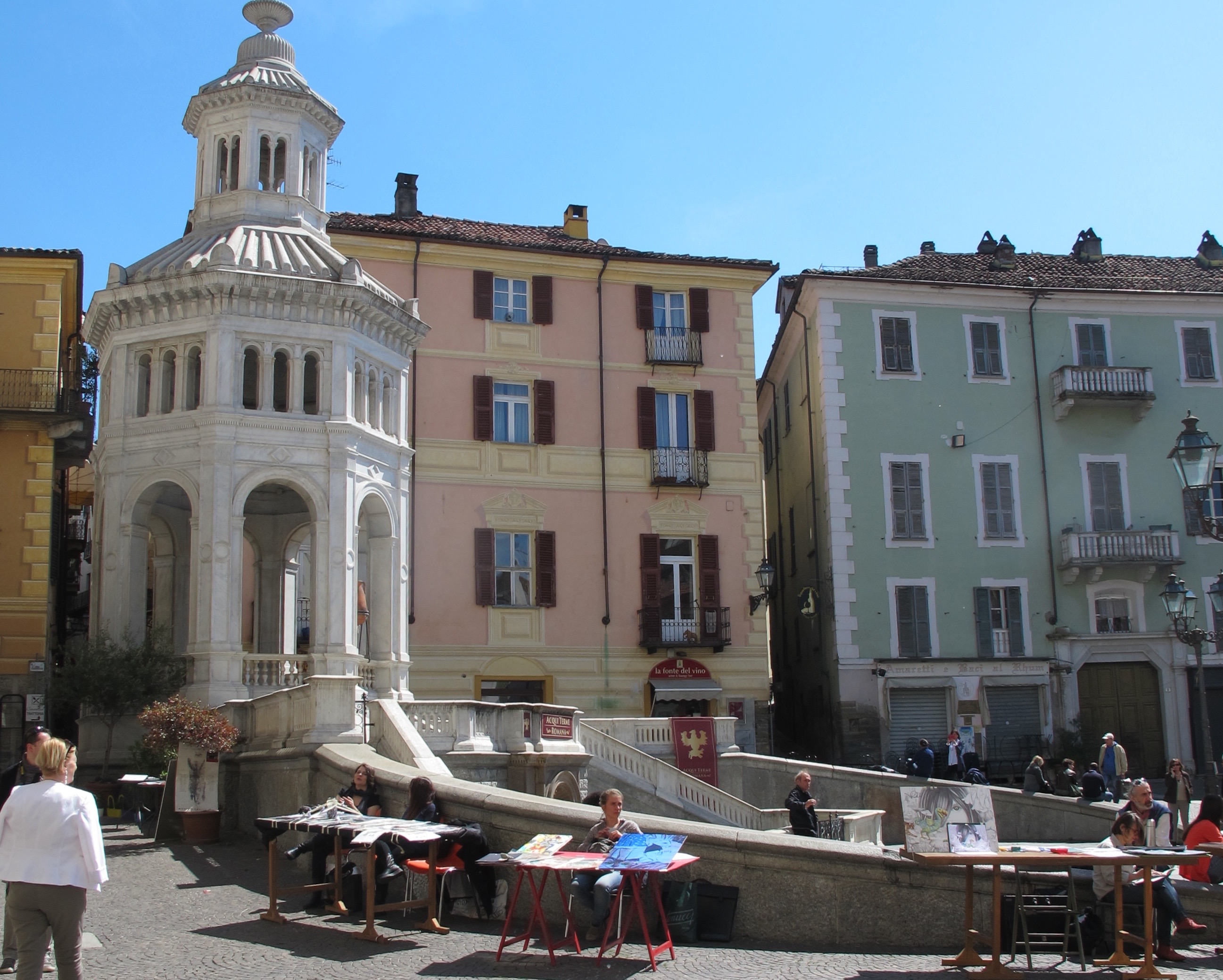
Thermal waters gush from La Bollente in the middle of Acqui Terme. Photo by Marla Norman.
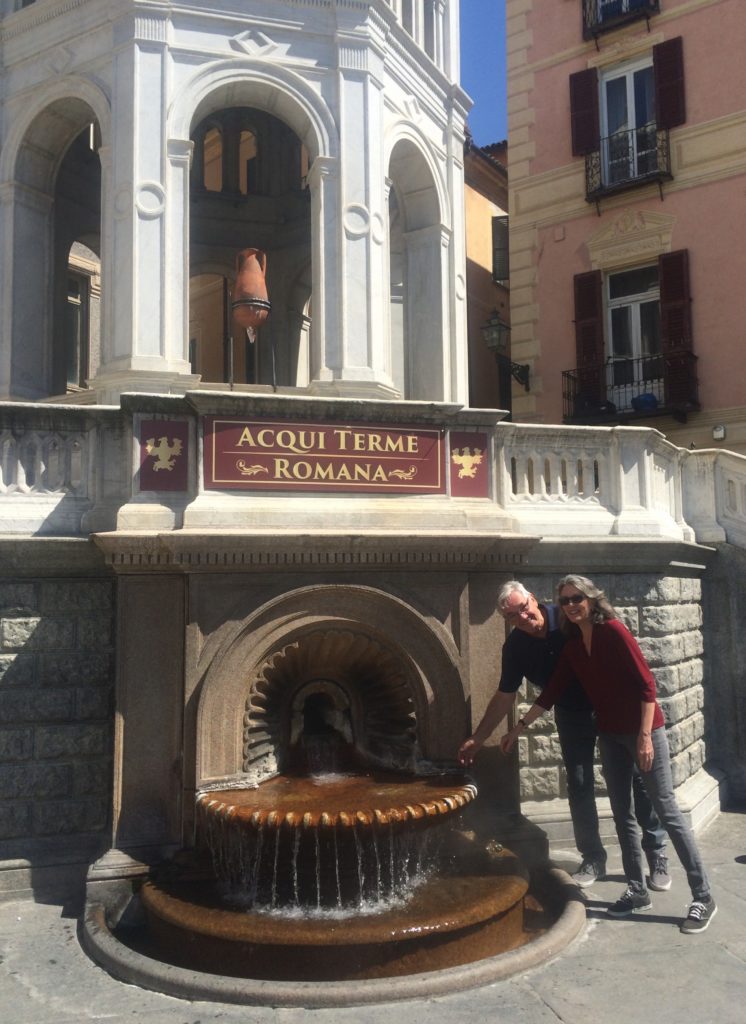
The VERY steamy waters of Acqui Terme are 75 Centigrade/167 Farenheit!
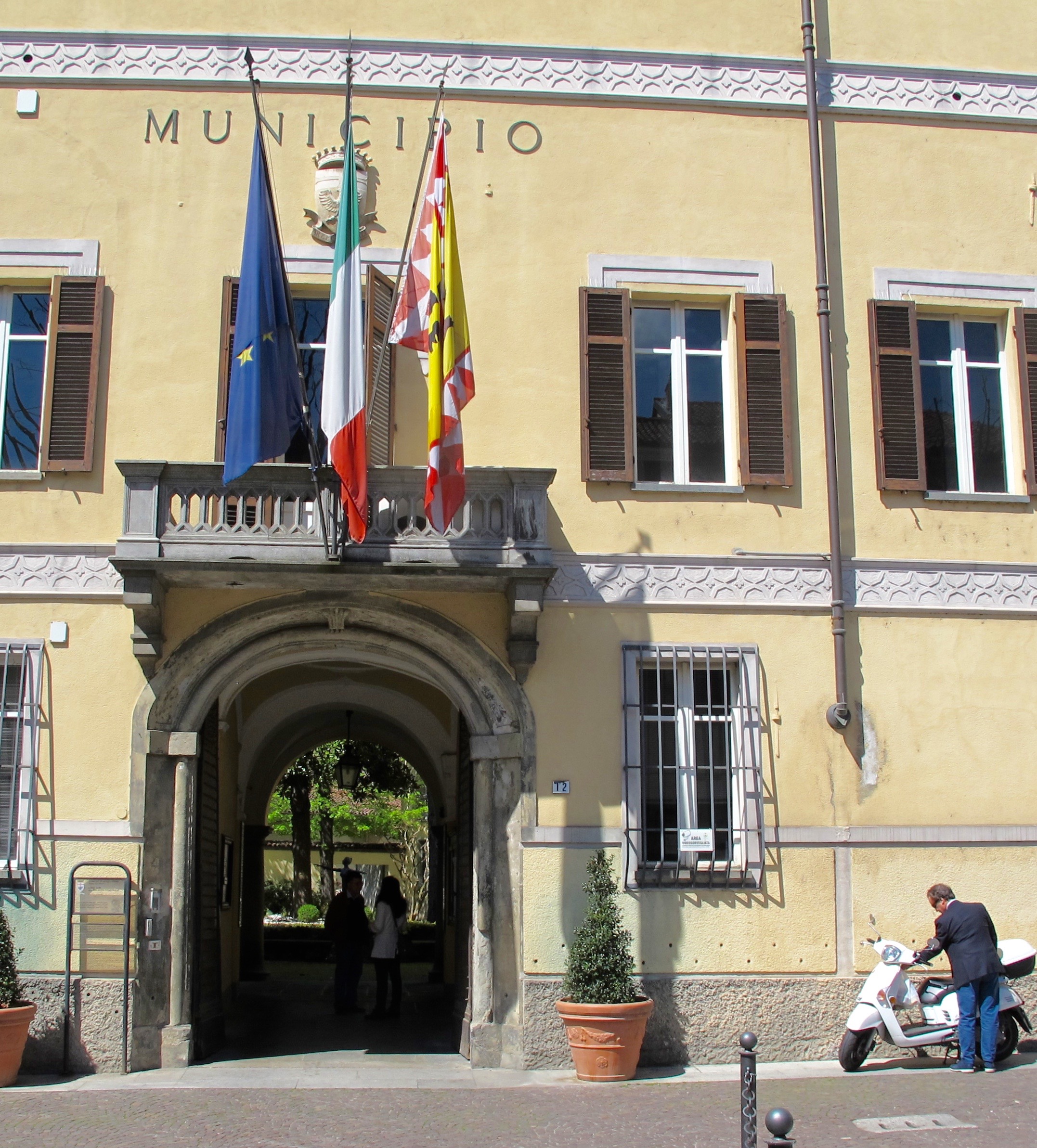
City Hall at Acqui Terme. Photo by Marla Norman
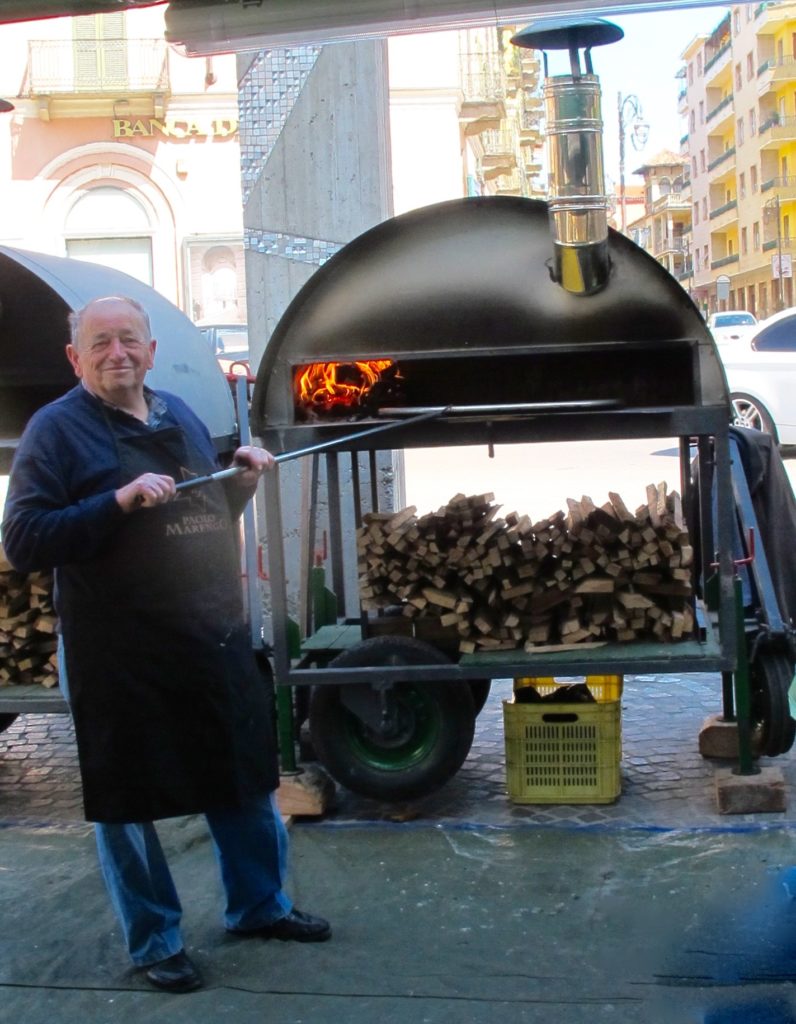
Hot pizza at the Farmer’s Market. Photo by Marla Norman.
Fine dinning is also part of the Acqui Terme experience. Truffles, cheeses, Barolo and Barbera wine (of course!) and local specialties such as bagna càuda, a piquant sauce made from olive oil, anchovies and garlic that is usually eaten with seasonal vegetables.
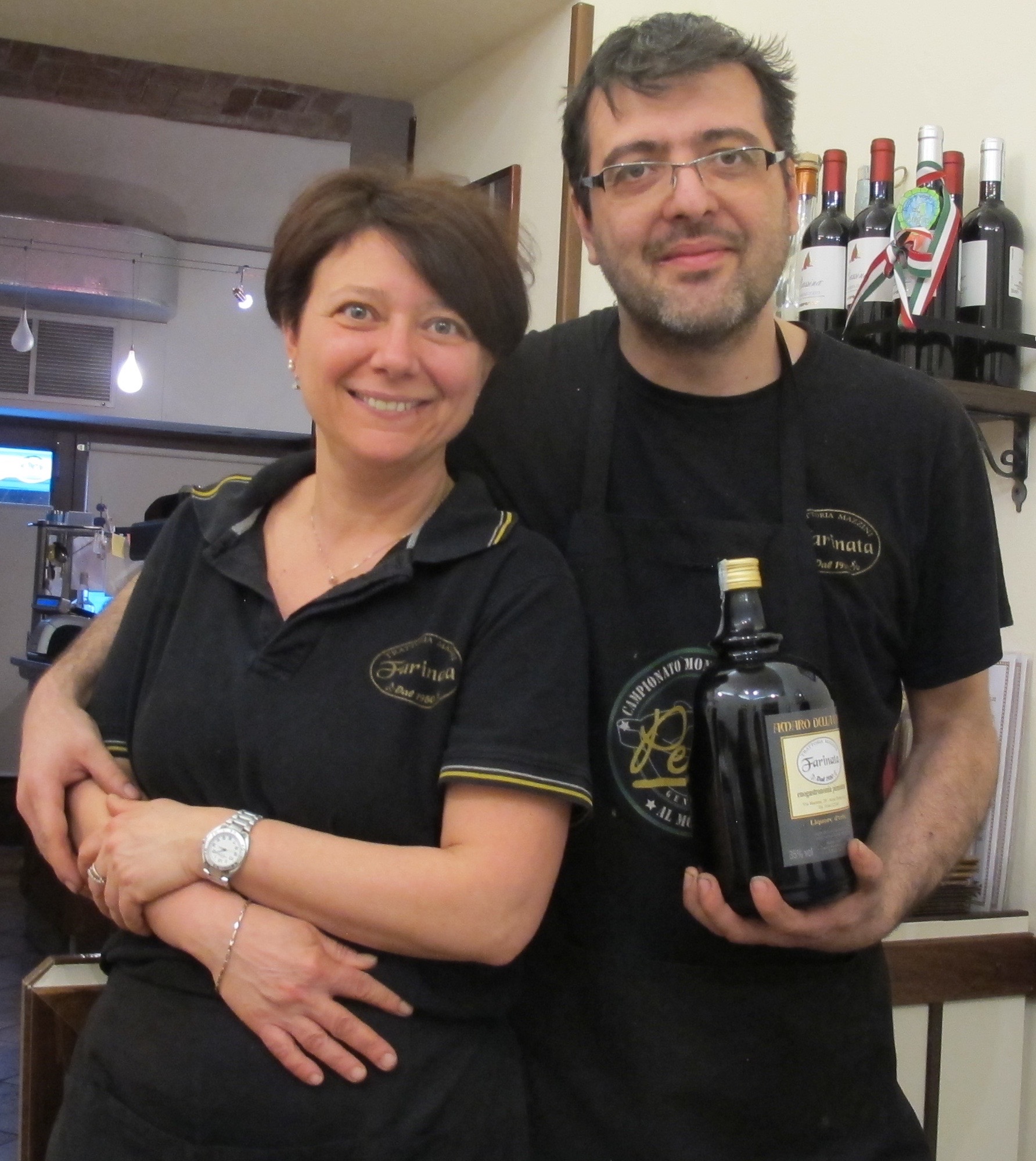
Denise and Danilo Mazzini, owners of Trattoria Mazzini.
Daniele and his boss, Claudio Negrino, are taking us to Trattoria Mazzini, whose specialty is Farinata in Forno – a kind of flatbread made from chickpea flour that is baked in a wood-burning oven. The owners, Danilo and Denise Mazzini show us around their charming three-room restaurant and seat us in a quiet corner.
Seconds later, the table is piled with antipasti – including heavenly bits of Robiola cheese wrapped in Prosciutto – and several bottles of wine. Claudio teaches us a typical Italian toast: “Il vino fa buon sanque” or “Wine creates good blood.”
A bit later, Denise reappears with a large plate piled with Farinata. The taste is rich, almost like a warm cornbread, while the texture is soft, almost cheesy. After we devour the Farinata, Denise brings plates of ravioli, fagioli, polenta and small, fried artichokes.
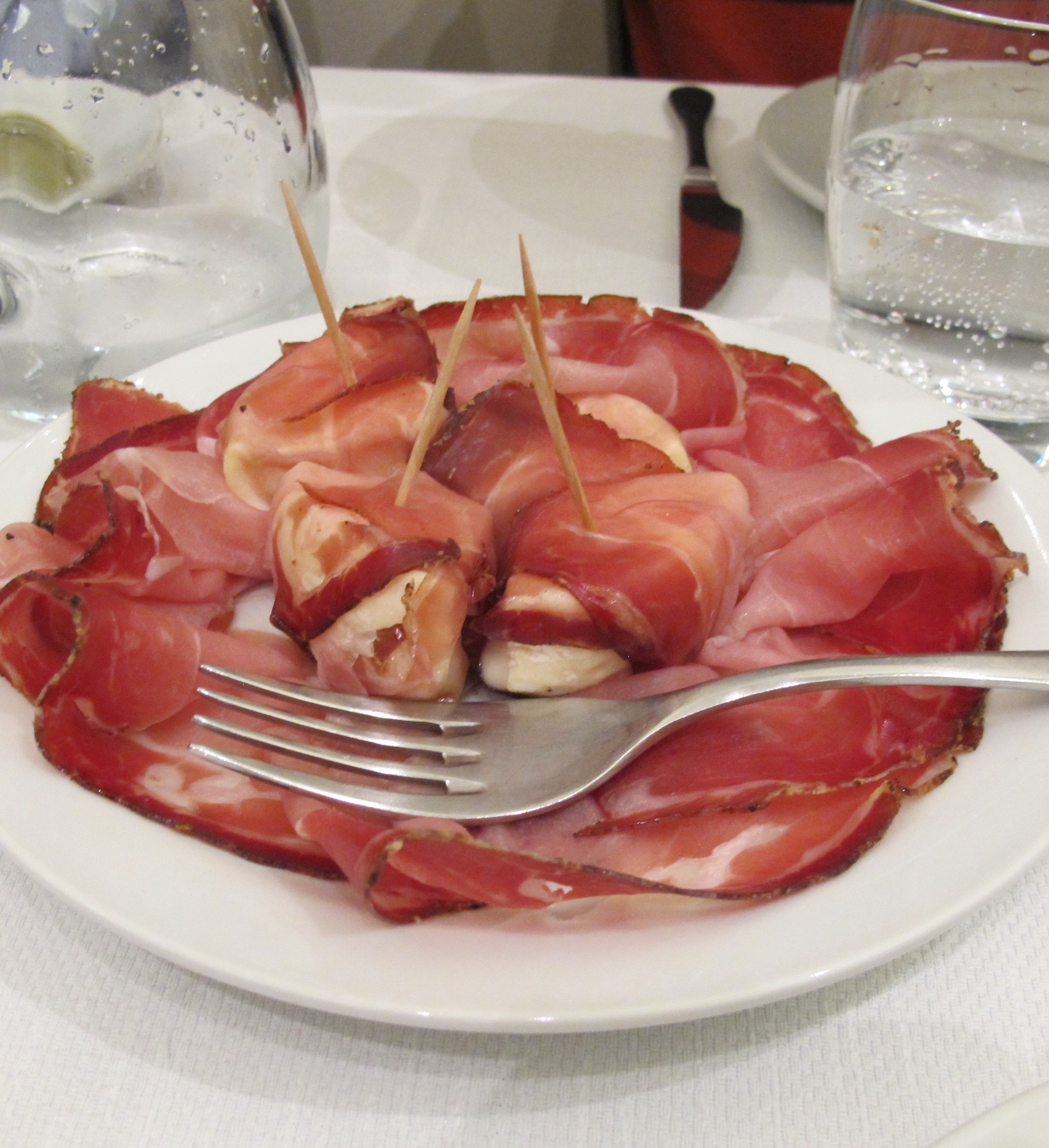
Heavenly bits of Robiola cheese wrapped in Prosciutto.
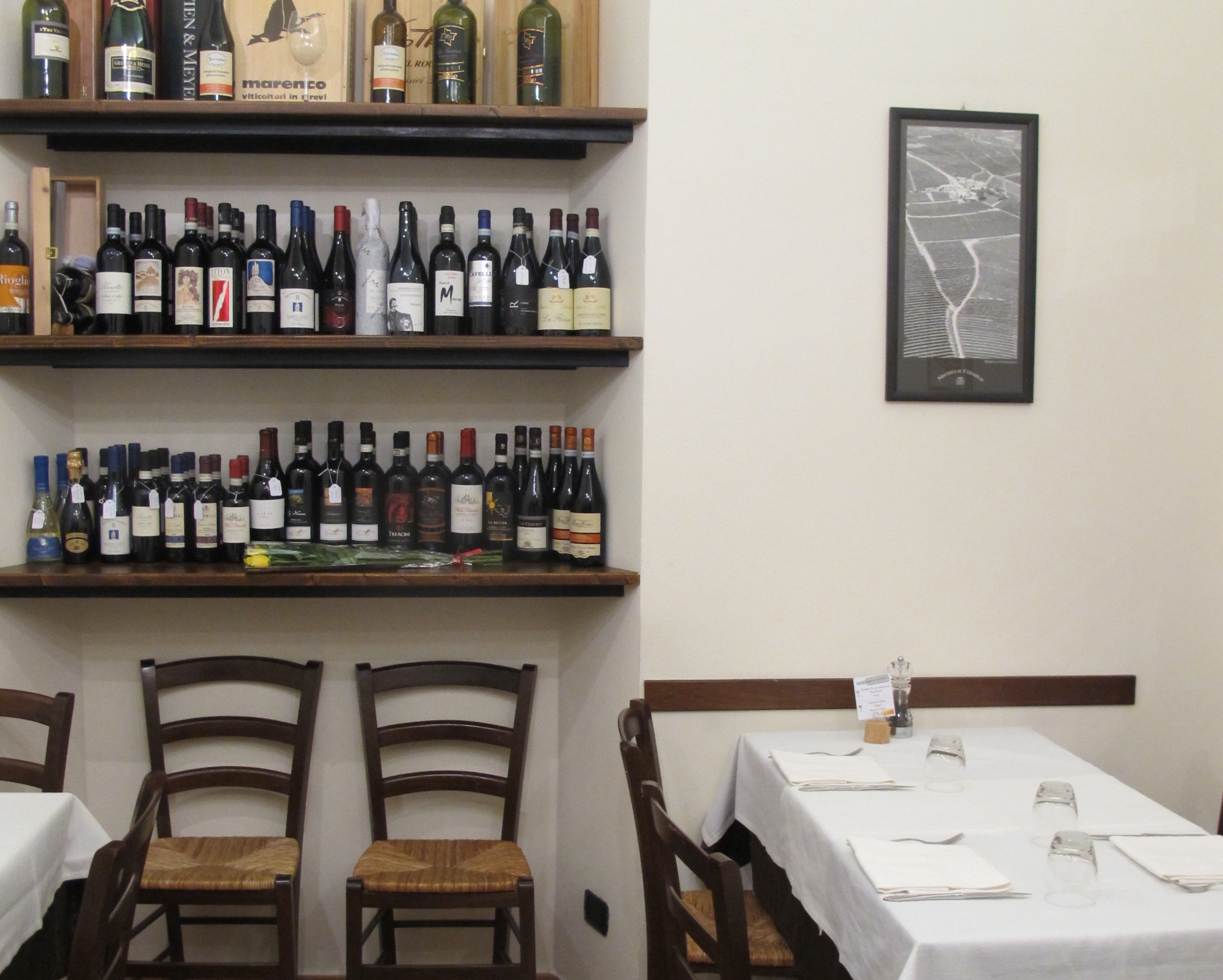
A few wine selections at Trattoria Mazzini. Photos by Marla Norman.
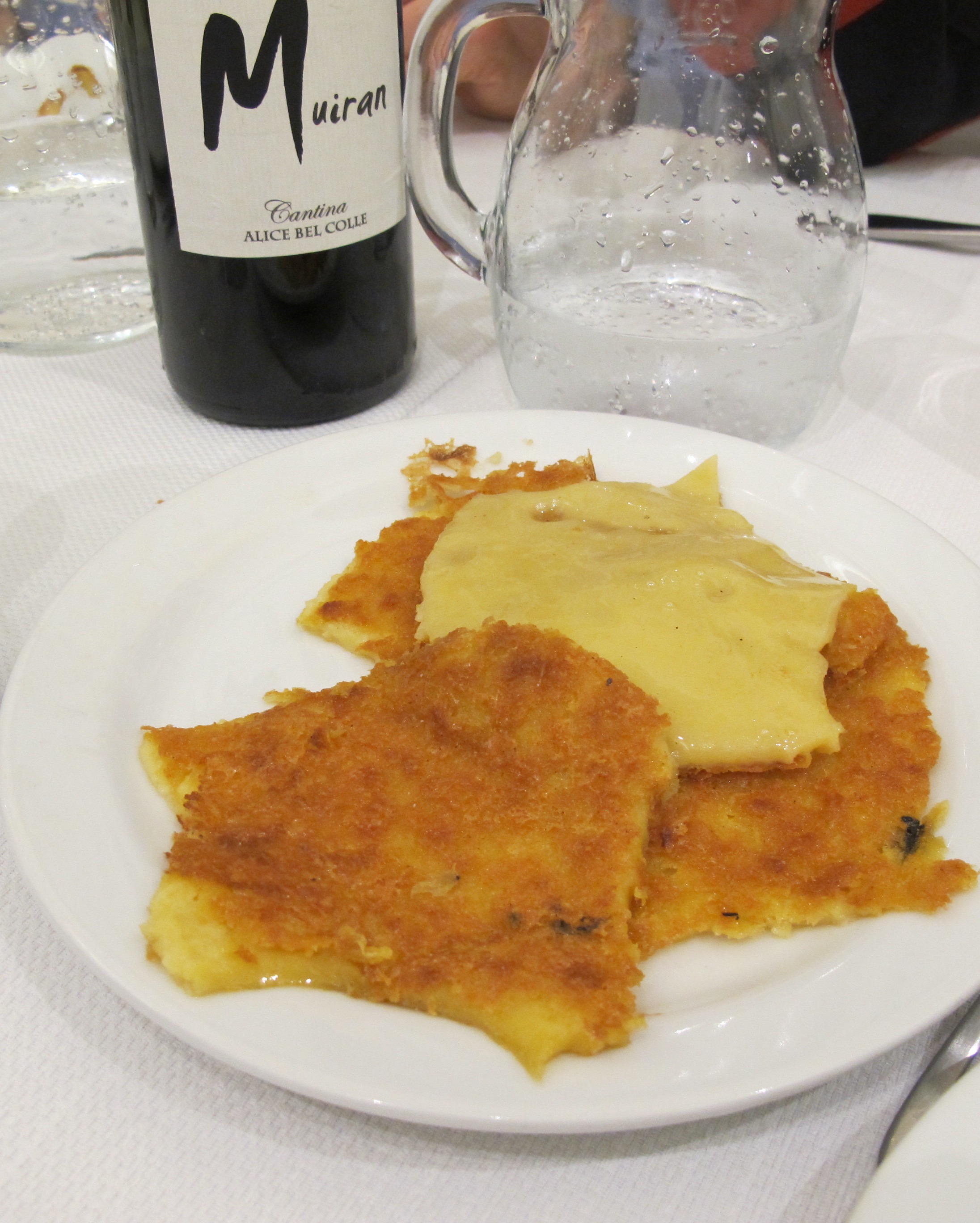
Farinata in forno – chickpea dough baked in a wood-fired oven.
Using bread to clean the last bit of sauce on his plate, Claudio exclaims, “Now we are making scarpetta – that means “little shoes” – our expression for enjoying every morsel of food.”
I think at the end of this incredible meal that “Fare la scarpetta” is also an apt description for our time in this beautiful hill country. Thanks to Daniele, Claudio and the group at Cantina Alice Bel Colle, we’ve experienced many different villages and aspects of Piedmont. We soaked in the culture, devoured the food and admired the wine. We savored and delighted in every moment – nothing left on our plates for this trip. We’ll return to feast again soon!
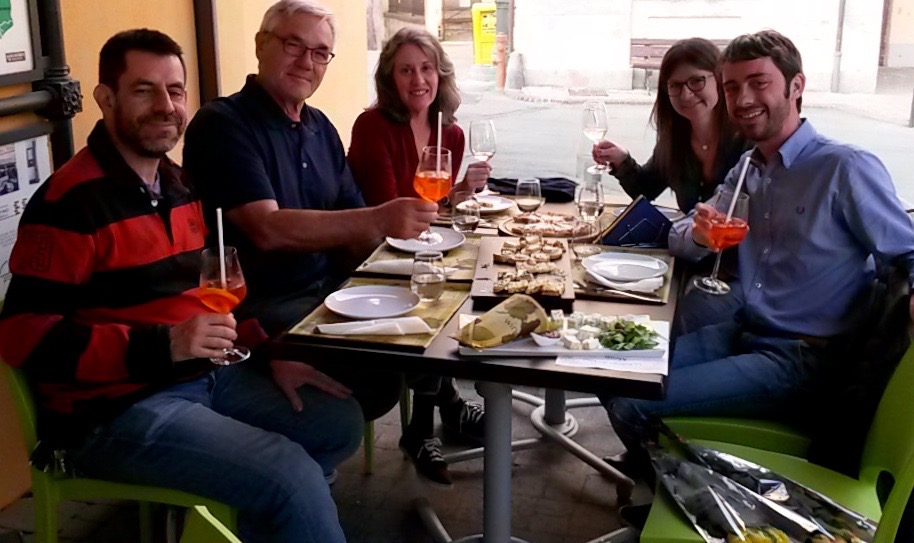
From Left to right: Claudio Negrino (Director of Cantina Alice Bel Colle), Michel Thibault (Michel Thibault Wine LLC), Marla Norman, (Travel Curious Often), Anna Prunotto, Daniele Bianco (Export Director for Cantina Alice Bel Colle)




